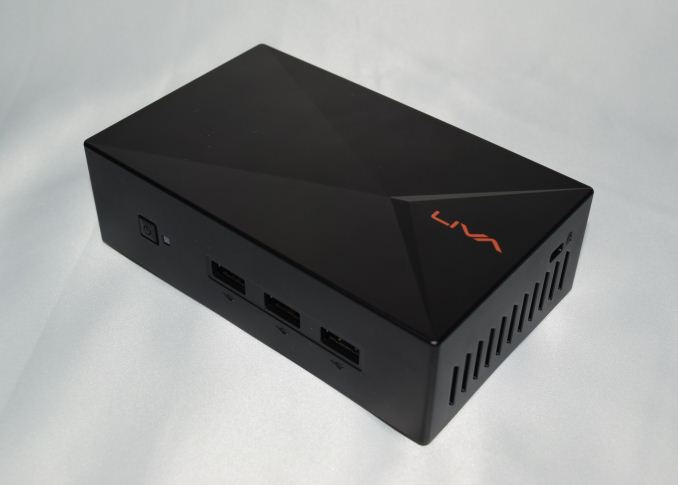ECS LIVA X Review: A Fanless Bay Trail-M mini-PC
by Ganesh T S on January 16, 2015 11:30 AM ESTFinal Words
The ECS LIVA X provided us with an opportunity to see how ECS could improve upon the baseline created by the ECS LIVA. We are happy to see that the LIVA X manages to fix many of the shortcomings without sacrificing any of the advantages brought forward by the LIVA. The misplaced thermal pads were a bit of a downer, but, considering that the LIVA had no thermal throttling issues and the heat sink is physically much better in the LIVA X, we have no doubt that customer shipments will not have any problems on that front.
The absence of SODIMM slots reduce the BOM cost and the eventual end-price for consumers (which is the reason the ECS LIVA X is cheaper than a Bay Trail NUC). A mSATA port makes an appearance for users interested in running Windows 7 (which doesn't have an eMMC driver). The Wi-Fi card came pre-installed, and the unit was good to go right after purchase, unlike the LIVA. The LIVA X provides an additional USB port and they are all in the front panel - that is a good decision considering the typical use case for such mini-PCs. The vertical orientation of the HDMI port also saves some space on the read panel, giving it a more uncluttered look.
The Celeron N2808 has Quick Sync enabled, and this provides some interesting use-cases. The availabiligy of a 64 GB SKU at launch is also welcome. 32 GB is not enough once a couple of Windows updates get installed.
Pricing is the final aspect that we will talk about. The 32 GB eMMC version will have a MSRP of $210, while the 64 GB version we evaluated will come in at $250. This is with 4 GB of RAM, but no OS. $250 is definitely a bit steep when we look at the competition. Particularly, the Zotac CI320 nano PLUS model with Win 8.1 + Bing sells for $252 with the operating system. It has a quad-core CPU and adopts passive cooling, just like the LIVA X. It has the 64 GB storage drive and DRAM replaceable too, in case things go wrong with those components. The WLAN card (1x1 802.11ac) is also better in the CI320 nano compared to the LIVA X (1x1 802.11n). The LIVA X does have 2 GB of RAM extra and a different industrial design (approximately the same volume, though). We still believe pricing must be much lower for better market reception. Other than that aspect, the ECS LIVA X ticks all the right boxes in terms of what users expect out of a passively cooled mini-PC.











35 Comments
View All Comments
Oxford Guy - Wednesday, January 21, 2015 - link
I'm not saying the test isn't interesting, but it's not particularly practical in this case. The only thing it does is let people know that if they want to run Furmark and Prime together they need to introduce some active cooling or a low ambient temperature. That's fine. There's nothing wrong with knowing that. However, it's not very high on the list of practical information.Oxford Guy - Monday, January 19, 2015 - link
"32 GB is not enough once a couple of Windows updates get installed."False. I have a 32 GB model and it has around 6 or 7 GB of free space with a fully updated Windows 8.1
random2 - Tuesday, January 20, 2015 - link
"...(UCFF) have emerged as one of the bright spots in the troubled PC market."Someone needs to do a study on the sales volumes seen in the PC component industry. There are a lot of people building these days rather than buying pre-made units from manufacturers like Cyberpower, Dell and others.
BrokenCrayons - Tuesday, January 20, 2015 - link
Thanks for posting idle and load power consumption numbers and addressing some reader concerns about the usefulness (or lack thereof) of delta charts where wattage is concerned.djfourmoney - Friday, July 3, 2015 - link
I like these tiny PC's. I was interested in the first Liva but it's shortcomings I knew would be addressed if I waited.As for case use -
Small HTPC. I have a Llano HTPC currently with a great ANTEC case with six drive slots not to mention the I can put two SSD's in it's 2.5 slot (no floppy) and replace the 5.25 slots with hot swap cages.
In other words it would make a very nice, fairly low draw server that can easily trans-code, among other things.
There was a time when I thought I would use the HTPC for more PC games, which is why I got the Llano but as time goes on, I use it more for console emulation when I do play games and I have PS2 and PS3.
Plus I can mount something like this on the back of a LCD and run everything else off a power USB 3.0 hub.
That said my Cable CARD tuner has to be hard reset every so often because it drops both tuners, I guess I could go with a network tuner but then I would need another cable run to where the router is.
Anyway, beyond that downgrading my HTPC seems to make sense to me. My original target was the Gigabyte Brix but only two AMD sku's are offered and the least expensive model might be discontinued and is hard to find.
m-ITX is an option but cost is off-putting.
Just thinking out loud I suppose.